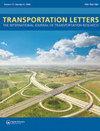基于具有均值异质性的相关随机参数生存模型的差距接受行为研究
IF 3.3
3区 工程技术
Q2 TRANSPORTATION
Transportation Letters-The International Journal of Transportation Research
Pub Date : 2025-02-07
DOI:10.1080/19427867.2024.2335742
引用次数: 0
摘要
本文旨在研究在考虑到驾驶员之间的异质性和高速公路上变道紧迫性的情况下,驾驶员在酌情变道操作过程中的间隙接受行为。本文章由计算机程序翻译,如有差异,请以英文原文为准。
Investigating gap acceptance behavior based on correlated random parameter survival model with heterogeneity in means
This paper aims to investigate gap acceptance behavior during discretionary lane-changing maneuvers considering the heterogeneity among drivers and lane-changing urgency on a freeway segment from a microscopic perspective. It was found that there were statistically significant differences in gap acceptance behavior between changing lane to the left/right. The accelerated failure time(AFT) model, random parameter AFT model, and correlated random parameters with heterogeneity in means AFT model were established. The results show that the third model have the best goodness of fit. There is obvious mean heterogeneity in the gap acceptance models of different lane change directions, and the correlation between random parameters significantly affects the gap acceptance behavior. The urgency of lane change has a significant heterogeneous effect on the lagging gap acceptance behavior of lane-changing drivers and is significantly correlated with other random parameters. The study results can help improve the safety lane-changing modules for connected and autonomous vehicles.
求助全文
通过发布文献求助,成功后即可免费获取论文全文。
去求助
来源期刊

Transportation Letters-The International Journal of Transportation Research
TRANSPORTATION SCIENCE & TECHNOLOGY-
CiteScore
6.40
自引率
14.30%
发文量
79
审稿时长
>12 weeks
期刊介绍:
Transportation Letters: The International Journal of Transportation Research is a quarterly journal that publishes high-quality peer-reviewed and mini-review papers as well as technical notes and book reviews on the state-of-the-art in transportation research.
The focus of Transportation Letters is on analytical and empirical findings, methodological papers, and theoretical and conceptual insights across all areas of research. Review resource papers that merge descriptions of the state-of-the-art with innovative and new methodological, theoretical, and conceptual insights spanning all areas of transportation research are invited and of particular interest.
 求助内容:
求助内容: 应助结果提醒方式:
应助结果提醒方式:


